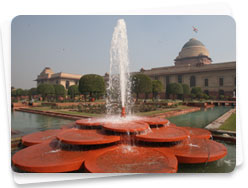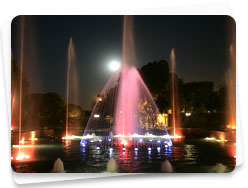New Delhi : Rashtrapati Bhawan

Rashtrapati Bhavan, home to the President of the world’s largest democracy, is emblematic of Indian democracy and its secular, plural and inclusive traditions. It was designed by Sir Edwin Lutyens and Herbert Baker and stands on a 330 acre estate. It took seventeen years to build this presidential palace which was completed in the year 1929. Almost seven hundred million bricks and three million cubic feet of stone were used in building this architectural marvel that has 2.5 kilometers of corridors and 190 acres of garden area. The main building covers an area of 5 acres and has 340 rooms spread over four floors. The famous Mughal Gardens of the Rashtrapati Bhavan cover an area of 15 acres and have 159 celebrated varieties of roses, 60 varieties of bougainvillea and many other verities of flowers. The Estate also has a state-of-the-art Rashtrapati Bhavan Museum Complex (RBMC) comprising the Clock Tower, the Stables and the Garages showcasing past as well as current presidencies, the regal ceremonies, and the rich flora and fauna of Rashtrapati Bhavan, amongst other things. The RBMC was inaugurated by President Pranab Mukherjee on 25th July, 2016.
For the convenience of the general public, Delhi Tourism has extended the facility of Ho-Ho Buses to the Rashtrapati Bhavan.
"For tourist desirous of visiting Rashtrapati Bhavan, prior online booking may be made."
For more details please visit http://rashtrapatisachivalaya.gov.in/rbtour
The Mughal dynasty practically came to an end when in 1803, the native rulers defeated by General Lake of East India Company near Patparganj. The East India appointed first resident of Delhi as the 'Protector' of battered Mughal crown. In the early years the British and their troops settled within the walled city around the Red Fort and Kashmere Gate. The city underwent drastic transformations after the war of 1857. One third of the city was razed to rubble in 1858 and the East India Company transferred the rule to the British Crown.
On 12th December, 1911, at the historic Delhi Durbar, the George V, the Emperor of the British Empire proclaimed the shifting of the capital of India from Calcutta to Delhi. After announcement of Delhi as the Capital of India, the preparation for the building a new city started with majesty, pomp and show. Thus came up a vary special city, New Delhi, the dream of Edwin Lutyens and Herbert Baker, city planners and architects. Built on the area in and around Raisina Hills, the new city housed among the landmarks, the Rastrapathi Bhawan, (Viceroy's House), the North and South Blocks of the Secretariat, and a Council Chamber which now houses India's Parliament, the 42 meters high memorial arch India Gate, Cannought Place and numerous roads, parks and other structures.

On the site where Delhi stands today, several cities have risen and decayed in the past. Their relics illustrate important phases in the architectural history of the country and are visible symbols of Delhi's glorious past. New Delhi, the capital of India's British rulers, was the eight in the series of city built one after another by successive lines of rulers. The national government, which took over on the attainment of independence in August, 1947, has not built another city. New Delhi, has, however, expanded manifold and is rapidly undergoing transformation. It is from New Delhi that most visitors form their first impression of the city. Much of the New Delhi was built between 1920-1930.
After independence, Delhi became the capital of new nation. With the advent of independence, its importance has increased manifold and Delhi has now became the political, economic and culture capital of country. The built - up heritage of Delhi are to be found in groups in the successive cities. Those which should not be missed by a visitors are the Qutub Minar and its adjuncts; Tughlagabad, Humayun's Tomb and shrine of Nizam-ud-Din; Sher Shah's fortS (Purna Qila), Red Fort and the Jama Masjid. To these might be added Kotla Feroz Shah, Safdarjung Tomb, Hauz-Khas, and the Lodi Tombs.








